from www.whitehousechristmascards.com
This website offers a treasure trove of information on the White House Christmas Cards and how the presidents celebrated the Christmas season. Here, we have selected a few presidents and share the information on how many White House traditions came to be, and how history often played a role.
The White House Christmas traditions that Americans enjoy today have grown and changed over time from one Presidential administration to the next. As Christmas became a more celebrated holiday, activity at the President’s residence reflected the focus on home, harmony, and peace.
White House Christmas cards have been officially sent out since 1953; however, Christmas cards were first offered for sale in America in 1875 and grew in popularity throughout the late 19th and early 20th centuries.
George Washington (1789-1797)
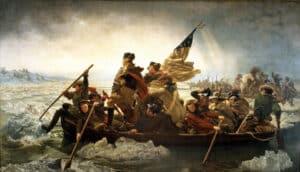
George Washington was the nation’s first president, and he set a high example for all future presidents to follow. President Washington was the only president who did not live in the White House. He was instrumental in selecting the design and location of the White House, but construction was not completed until after he left office.
President Washington and his wife, Martha, were very big entertainers at Christmas. Although Christmas cards were not used until the mid-19th Century, George and Martha sent many invitations during the eight Christmas seasons that George ran the United States, and they were often joined by relatives, friends, and many prominent people of the time. Washington was considered a fair man and would give his slaves and servants a good Christmas holiday. The only people who did not have days off for Christmas were the house servants.
The Washingtons spent lavishly; they loved music, dance, and festive occasions and would send hand-written invitations to friends and family to celebrate the twelve days of Christmas. These were considered the “Christmas cards” of the 1800s.
Thomas Jefferson (1801-1809)
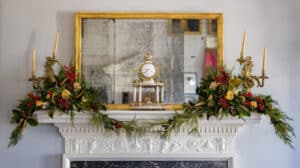
decorated for the season in the style of Jefferson’s time.
For most of our earlier presidents, there is very little documented information regarding Christmas celebrations or traditions they or their families may have practiced. However, whether it is because he was a prolific letter writer or that scholars have accumulated a wealth of information on his life from painstaking research, there is more information describing the Christmas celebrations of our third president.
Christmas celebrations at the Jefferson White House were festive affairs where delicacies and local American foods were served. Since Jefferson was a widower, Dolley Madison served as the hostess in 1805 and Jefferson played the violin for the dancing children. His slaves were allowed a few days of holiday respite over Christmas. During that time, they were able to travel to visit friends and relatives. Those staying at Monticello would celebrate by eating fresh meat instead of the usual cornmeal and pork.
Franklin Pierce (1853-1857)
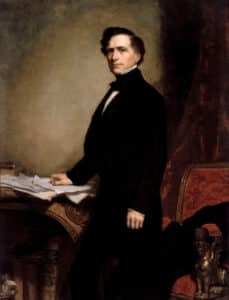
While Christmas Cards had still not been considered part of the norm for the White House holiday season, Pierce did have a Christmas tree put up within its walls. Pierce is widely hailed as having the first White House tree, but it would not be until 1923 when President Calvin Coolidge lit up the first “National Christmas Tree” on the White House lawn.
Pierce had the Christmas tree decorated in 1856 for a group of Washington D.C. Sunday School children. The practice of putting up a Christmas tree was brought to the United States by German immigrants and was in vogue during the mid-1800s. Prior to this, decorations consisted of holly and pinecones and sprigs of green. The White House was much more festive for this Christmas celebration, and carolers sang Hark! the Herald Angels Sing to the children.
It was the Pierce White House that served as the inspiration for the first White House ornament created in 1997. The ornament depicts the White House lawn with people strolling on the grounds in a casual fashion. This peaceful scene demonstrated the only time during the Pierce administration which was calm and celebratory, as the Civil War was on its way.
Abraham Lincoln (1861-1865)
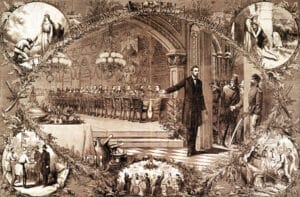
December 25 was considered a normal workday. Years before his presidency, when Lincoln was a legislator in Illinois in 1834, there was a special vote taken to decide whether elected officials should be allowed to take Christmas Day off. Lincoln voted no, as he felt he would be wasting the taxpayer’s money if he did so.
During his presidency, Lincoln had one Christmas filled with his entire family after a morning filled with an important Cabinet meeting. White House Christmases after this first one were relatively sad occasions due to the death of Lincoln’s son, Willie, in February the following year. The Lincolns made it a point to spend future holidays visiting hospitals and lifting the spirits of those who served and were suffering. Son Tad Lincoln was so deeply moved that President Lincoln arranged to have Christmas gifts, such as reading material and sanitary clothes, sent to the soldiers under the signature, “From Tad Lincoln.”
President Lincoln started quite a few soon-to-be-considered “traditions” during his tenure. His son Tad begged his father not to kill a certain turkey (named Jack) for Christmas and Lincoln wrote an official pardon saving the turkey’s life. In 1863, Lincoln officially proclaimed that the last Thursday in November be considered a day of Thanksgiving. Prior to this proclamation, Thanksgiving was a regional holiday in New England and had been celebrated only sporadically. Congress passed a resolution to this effect but not until 1941.
Ulysses S. Grant (1869-1877)
To say that the Christmas holiday as we know it may not have existed if not for President Grant could be considered a truth. During his first presidential term in 1870, the formal General in Chief of the Union Army signed into law the bill that had been introduced by Illinois Congressman Burton Chauncey Cook, making Christmas a legal holiday. The bill also declared that New Year’s Day, the 4th of July, and Thanksgiving Day would also be national holidays.
Another significant Christmas-related event involving Grant was the name in 1867 of a giant sequoia tree as the General Grant Tree (this took place two years after the end of the Civil War and two years before Grant was elected president). Today, this approximately 2,000-year-old tree measures about 270 feet high, 40 feet across at its base, with a circumference of 108 feet. In 1926, President Coolidge proclaimed the huge sequoia the “Nation’s Christmas Tree.”
Grover Cleveland (1885-1889 and 1893-1897)
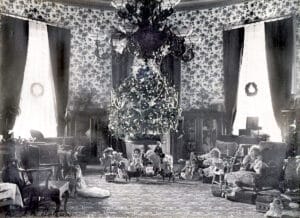
electric light bulbs, delighted the president’s young daughters. It was placed
in the second-floor Oval Room of the White House just
three years after the installation of electricity.
Even though Christmas Cards were becoming popular once they were first offered for sale in 1886, it is blurry at best as to whether this two-term President ever sent them out. Grover Cleveland entered the White House as a bachelor and married the daughter of his former law partner, Miss Frances Folsom, one year later. This modern, young (fresh out of college at 21) First Lady helped turn the page for more festive Christmas celebrations held at the White House.
President and Mrs. Cleveland spent their first Christmas together at their farm called “Red Top” (as the President called his wife) with her mother. The Washington Post reported that the First Lady had the house decorated with English holly and evergreens, and “in one of the rooms a pretty Christmas tree.” The new Mrs. Cleveland had been seen downtown, prior to Christmas, shopping in the crowded shops and she “gently elbowed her way through, and had a pleasant word for the tired shop girls.” Mrs. Cleveland joined a local club and they provided a Christmas banquet for the poor children of Washington. It was she who set a tradition of good works to be done by the First Lady at holiday time. Cleveland once wrote of his wife, “I have in her something better than the Presidency for life.”
In 1895, when their first child, Ruth, was just one (the Clevelands had five children altogether), a Christmas tree was erected and decorated with gold angels, gold and silver sleds, lots of tinsel, and the very first electric lights to be put on a Christmas tree in the White House. The multi-colored lights replaced candles for the first time.
Electric lights soon became popular when people heard that they were used in the White House. Under the tree were dolls, a doll house, and a miniature White House.
Calvin Coolidge (1923-1929)
As the 30th President of the United States, Calvin Coolidge was the first to truly extend a White House Christmas celebration to the American people. During his first Christmas in the White House in 1923, he initiated the tradition of the National Community Christmas Tree. A 48-foot Balsam Fir from his native state of Vermont was erected on The Ellipse, and an electric button enabled the President to light the tree on demand for the first-ever National Community Christmas Tree Lighting Ceremony.
During the summer of 1924, Coolidge’s youngest son, Calvin, Jr., died of staphylococcus septicemia (better known as blood poisoning), an event that was said to have changed “Silent Cal” forever. That same year, the White House received a record-setting 12,000 Christmas cards from the American public.
Coolidge was known for his stoic and serious demeanor. But in 1926, after receiving so many heartfelt gifts and Christmas cards from the American people, Coolidge was so emotionally affected that he gave a gift of a gold coin to all of the White House officials and staff members.
President Coolidge and his wife were known to send Christmas cards to close friends and family. But in 1927, when Coolidge was again being bombarded with requests to share a Christmas message with the public, he finally agreed. On Christmas morning, a short, handwritten message from the President appeared in every major newspaper, making this the first Christmas greeting to be given to the American public from a president.
Dwight D. Eisenhower (1953-1961)
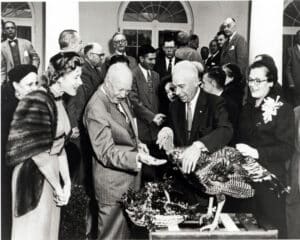
As General of the United States Army and Supreme Allied Commander during World War II, Dwight D. Eisenhower easily became a well-liked man on domestic soil. “I Like Ike” helped Eisenhower win the presidency by a landslide to become the 34th President of the United States of America.
During his first Christmas in the White House in 1953, Eisenhower referred to Hallmark President Joyce C. Hall for help with his first official Christmas cards as the President. An artist himself, Eisenhower painted a portrait of Abraham Lincoln while waiting for news on a Korean armistice. The portrait was based on an 1863 portrait of Lincoln by Alexander Gardner. With this, Eisenhower ordered 1,100 white keepsake folders from Hallmark, each containing a reproduction of his Lincoln portrait. All of the folders were embossed with the official Presidential Seal along with the words “Season’s Greetings” in gold. “The President and Mrs. Eisenhower extend their best wishes for Christmas and the New Year” was engraved in black on the inside of each card.
Hallmark also produced 500 informal Christmas cards for the President and First Lady to send to their close and personal friends. The design of the informal cards contained an embossment of holly leaves and red berries; “Mamie and Ike” was engraved on the inside in the First Lady’s handwriting.
Before lighting his first National Community Christmas Tree for over 4,000 onlookers, Eisenhower gave the President’s annual Christmas speech from inside the White House via radio and television, and it was trans-mitted around the world by Voice of America radio in over
30 languages.
The Lincoln portrait was so popular that Eisenhower painted George Washington and the prints were given as a Christmas gift in 1954. This was painted during a fishing trip to Colorado. This year, he ordered 1,300 official White House Christmas Cards.
Then, in 1955, Eisenhower painted a landscape but suffered a heart attack without finishing the painting titled St. Louis Creek, Byers Peak Ranch. He did complete the painting while recovering at the hospital.
Eisenhower’s tradition of creating a painting and sending cards with the image at Christmastime continued throughout his tenure as President, and Hallmark continued to provide Christmas cards to the White House each year.
John F. Kennedy (1961-1963)
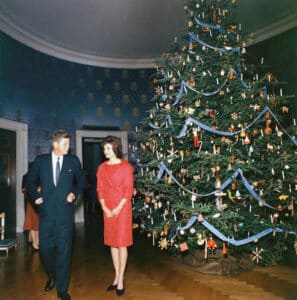
For the Kennedy’s first Christmas in the White House in 1961, as a Christmas gift to their staff, they gave a photograph of little Caroline Kennedy’s ducks in the fountain on the South Lawn with the White House in the background. Caroline, only five years old at the time, had raised the ducks since they were ducklings. Eventually, the ducks were relocated to Rock Creek Park in northwest D.C.
Hallmark was still producing Christmas greetings for the White House. Hallmark reproduced 1,000 color gift prints that were given to White House staff members at an informal reception.
The official White House Christmas Cards featured a wide green silk-screened banner on a smooth white stock accompanied by the
official Presidential Seal and the sentiment “Season’s Greetings 1961” engraved in gold. The inside read, “The President and Mrs. Kennedy wish you a Blessed Christmas and a Happy New Year.” President Kennedy ordered 800 official Christmas cards from Hallmark. Additionally, since the President was sending Christmas cards to leaders around the world, he ordered another 100 cards with a general New Year’s imprint that did not make any mention of Christmas.
The lighting of the National Christmas Tree was overseen by Vice President Johnson since the Kennedy family was with the family after patriarch Joseph Kennedy suffered a stroke. Johnson spoke of the nation’s dedication to seeking world peace, comparing that dedication to Christ’s quest for unity.
This “Camelot” family brought the American Public into the People’s House thanks to its First Lady, Jacqueline Bouvier Kennedy. Mrs. Kennedy’s mission was to turn the White House into a showcase of American art and history. By early 1962, four rooms had been completed and restored back to their original grandeur with Jackie welcoming the nation and the media to witness and experience her grand-scale works. American artist Edward Lehman, best known for his advertising illustrations, was commissioned to paint a 20 x 30-inch watercolor of the Red Room. The Kennedys were so impressed, that the image was reproduced and used as the White House 1962 Christmas gifts to the White House staff.Jackie also created the White House Historical Association and gifted its published book The White House, An Historic Guide to members of the Cabinet and senior staff.
The official White House Christmas cards were also given a bit of a makeover when the Kennedys used a photograph depicting Mrs. Kennedy sitting with John Jr. in a one-horse open sleigh being led by Caroline’s pony, Macaroni, on the cover.
On December 17 at 5:15 p.m., President Kennedy lit the National Community Christmas tree at the Pageant of Peace. It was the only year he was present at the ceremony. With the Cuban Missile Crisis ensuing only two months prior, the President spoke of peace in his Christmas message to the American people. He expressed hope for peace “after a year with peace [had] been sorely tried.”
Lehman was once again invited to paint watercolors of the newly remodeled Green Room and Blue Room. The Green Room was
reproduced by Hallmark and 2,300 were distributed that year. Three hundred prints were retained by Hallmark, 200 of which were requested by the White House to have no personalized message and no folder.
Lehman returned to the White House to finish his watercolor of the Blue Room, which the President and Mrs. Kennedy were planning to use for the 1964 Christmas season as gifts to the staff. The painting was finished but never reproduced after the President’s assassination on November 22, 1963.
Mrs. Kennedy did give the Green Room Christmas gift prints to members of the White House staff after the President’s death, but the official White House Christmas cards of 1963 were never distributed. The design is a color photograph of the crèche in the East Room accompanied by a gold embossed Presidential Seal and the message “With our wishes for a Blessed Christmas and a Happy New Year.” Only a few days before going to Dallas, the President and First Lady personally signed about 30 Christmas cards, which are perhaps the rarest Christmas cards of any President in modern times.
Ronald Reagan (1981-1989)
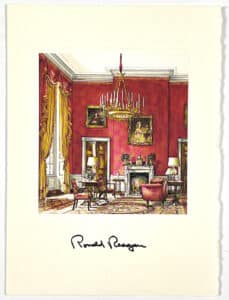
White House Christmas Card for 1982 in a beautiful Christmas red and signed by the President.
Over the course of eight years, the 40th President of the United States, Ronald Reagan, with his wife, Nancy, were on a mission when it came to designing their Christmas cards. The Reagans decided to send out White House Christmas cards that would share the “aura” of the White House at Christmastime. They wanted to encourage young artists, so they would have a different artist do a representation of the White House every year and use these for their official White House Christmas cards. This produced eight varied views of the White House “aura” in all its holiday regalia.
Each of the eight Christmas cards designed for the Reagans was centered on the architecture, atmosphere, and nature of the White House as a home for the President. The number of printed cards at the start of the Reagan Presidency began at 65,000 and rose to 125,000 over the course of his eight years in office. Selected artists were asked to submit samples of their work for consideration. Among those selected was Jamie Wyeth, whose grandfather N.C. Wyeth produced Christmas cards for the Nixon White House, James Steinmeyer, Mark Hampton, and Thomas William Jones, who did several cards.
Hundreds of volunteers were gathered to help with the processing of Christmas cards being sent out by the White House for a few
administrations by the time the Reagans were in America’s Home. In 1983, for example, 400 volunteers from the Office of Presidential Inquiry helped to hand-address every Christmas card envelope. The envelopes were written in black ink without abbreviating any streets or states. White House Christmas cards that were sent to past presidents, members of the Supreme Court, the Senate, and the House of Representatives were written by a professional calligrapher, Kathlyn Peake, whose work was considered an art form. There were also 7,500-holiday gift prints made of the selection by Mark Hampton, simply titled Green Room at the White House.
Like her predecessor Jackie Kennedy, Nancy Reagan figuratively opened the doors of the White House to the people with an NBC special that featured a tour of the decorated rooms led by Mrs. Reagan along with a history of White House Christmases.
Barack Obama (2009-2017)
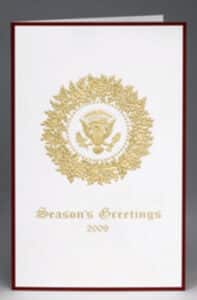
Presidential Christmas card
of President Barack Obama
and first lady Michele Obama. Season’s Greetings, 2009.
Message reads: “May your
family have a joyous holiday
season and a new year blessed
with hope and happiness.”
President and Mrs. Barack Obama entered the White House with two young daughters and a lot of joyful energy as America looked on. During their first year in the executive mansion, the President and First Lady Michelle Obama’s selection of their White House Christmas card caused some controversy in that there was no mention of the word “Christmas” anywhere on the front side or inside of their card. The front of the very stylish, cream-colored card, featuring a gold wreath surrounding a gold presidential coat of arms and containing a maroon border, said “Season’s Greetings,” with “2009” centered below. The inside verse offered good wishes to the Presidential Christmas cards’ recipients: “May your family have a joyous holiday season and a new year blessed with hope and happiness.”
The fact that there was no printing of a biblical passage (as was done during the George W. Bush tenure) nor an artist’s depiction of decorations in one of the rooms in the White House (as was on the Clinton’s cards) certainly brought out the critics. Representative Henry Brown, a Republican from South Carolina, even introduced a resolution for the defense of the sacredness of the Christmas holiday, saying, “I believe that sending a Christmas card without referencing a holiday and its purpose limits the Christmas celebration in favor of a more politically correct holiday.” Over 40 Democrats and Republicans co-signed the bill.
A White House spokesperson indicated that certainly no slight was intended and that the Presidential family recognized that many Americans celebrate different holidays at the end of the year and at the beginning of the new year, and the Obamas’ White House Christmas cards reflect that thought. The Obamas’ cards hardly broke any new ground; George W. Bush’s distributed White House Christmas cards did not mention “Christmas,” either.
Certainly, there could not have been too many differences of opinion regarding the behavior or practices of events in which the First Family participated once the 2009 holiday season arrived. On November 27th, the day after Thanksgiving, Michelle Obama along with First Daughters Malia and Sasha accepted delivery of the 18½ foot Douglas fir tree which was to serve as the White House Christmas tree. The next day, Michelle and the girls were accompanied by the President, who together counted down to the moment when all four pressed the button that lit the National Christmas tree. President Obama joked, “I’m technologically challenged and I might not get this right.”
As Christmas Day drew closer, President Obama, interviewed by singer Gloria Estefan, explained that Santa would be entering the White House on Christmas Eve using the chimney in the Yellow Room, and that milk and cookies would be there for the red-suited man’s consumption.
On December 22, the First Lady along with Malia and Sasha and the family dog, Bo, paid a Christmas visit to the Children’s National Medical Center visiting heart and kidney patients. They were then led to the center’s atrium area where Michelle Obama read ‘Twas the Night Before Christmas to a larger group of children. Additionally, Malia and Sasha alternated reading from Snowmen at Night, a children’s picture book.
On Christmas Eve, the family boarded Air Force One for their annual vacation in Hawaii, where Barack Obama was born in Honolulu on August 4, 1961.





Related posts: